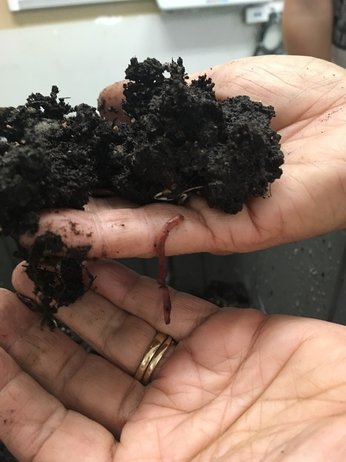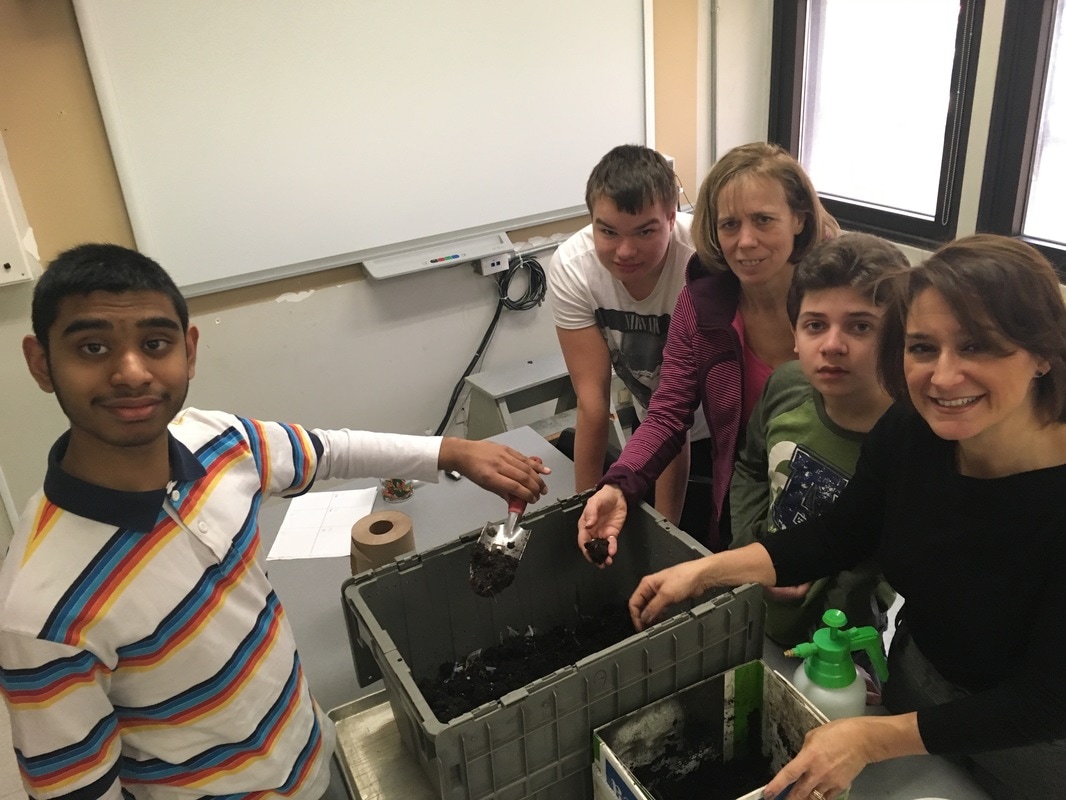
It's a NEW YEAR, and even though I haven't blogged in awhile it doesn't mean that the JRHS Resource students haven't been busy gardening indoors. Just before the holidays for instance, we learned about food chains and the valuable creatures that make up ecosystems. We watched a couple of fun, food chain videos and learned how CONSUMERS (insects and large animals), PRODUCERS (plants) and DECOMPOSERS (soil organisms) all have important roles to play in food webs to keepboth local and global ecosystems balanced and healthy.
This past week in the Resource department, it was all about VERMICOMPOSTING, a type of composting that happens indoors rather than outdoors in the yard. It's a good alternative for those who do not have backyards and want to do their part in reducing food waste.
We made our own RESOURCE WORM BIN by first cleaning then drilling holes into an old plastic bin with a lid. Next, we added shredded and moistened computer paper and newspaper for the worms' bedding, threw in some earth and a little sand, then added the most important players: the worms, (thanks to Mr. Cadot, the science teacher who gave us worms from his own small worm bin in the science lab.) A large tray was placed under the bin which will collect any precious vermi compost liquid that drips from the bin and which will be diluted to fertilize our plants.
Resource students learned a lot about red wrigglers (a.k.a. Eisenia Foetida), the worms that create vermicompost. Different from earthworms, red wrigglers are important decomposers naturally found in decaying leaves and manure piles and are native to temperate areas so they can't live in the extreme temperatures found in our outdoor Canadian compost piles. They will die at temperatures above 32 degrees Celcius and become inactive or freeze when temperatures are too low. Red wrigglers are vegetarians that prefer a moist, not too acidic environment, so the students will have to be careful what they feed them: mainly small pieces of scrap vegetable and fruit and not too many citrus fruit. They will have to take care to bury the food they feed the worms placing it it in a different area of the bin each time and hopefully in a few months, the worms will have transformed our food waste into a clean, high quality compost that can be used to fertilize all our container-grown plants. I can't wait to harvest the results!
This past week in the Resource department, it was all about VERMICOMPOSTING, a type of composting that happens indoors rather than outdoors in the yard. It's a good alternative for those who do not have backyards and want to do their part in reducing food waste.
We made our own RESOURCE WORM BIN by first cleaning then drilling holes into an old plastic bin with a lid. Next, we added shredded and moistened computer paper and newspaper for the worms' bedding, threw in some earth and a little sand, then added the most important players: the worms, (thanks to Mr. Cadot, the science teacher who gave us worms from his own small worm bin in the science lab.) A large tray was placed under the bin which will collect any precious vermi compost liquid that drips from the bin and which will be diluted to fertilize our plants.
Resource students learned a lot about red wrigglers (a.k.a. Eisenia Foetida), the worms that create vermicompost. Different from earthworms, red wrigglers are important decomposers naturally found in decaying leaves and manure piles and are native to temperate areas so they can't live in the extreme temperatures found in our outdoor Canadian compost piles. They will die at temperatures above 32 degrees Celcius and become inactive or freeze when temperatures are too low. Red wrigglers are vegetarians that prefer a moist, not too acidic environment, so the students will have to be careful what they feed them: mainly small pieces of scrap vegetable and fruit and not too many citrus fruit. They will have to take care to bury the food they feed the worms placing it it in a different area of the bin each time and hopefully in a few months, the worms will have transformed our food waste into a clean, high quality compost that can be used to fertilize all our container-grown plants. I can't wait to harvest the results!

 RSS Feed
RSS Feed
